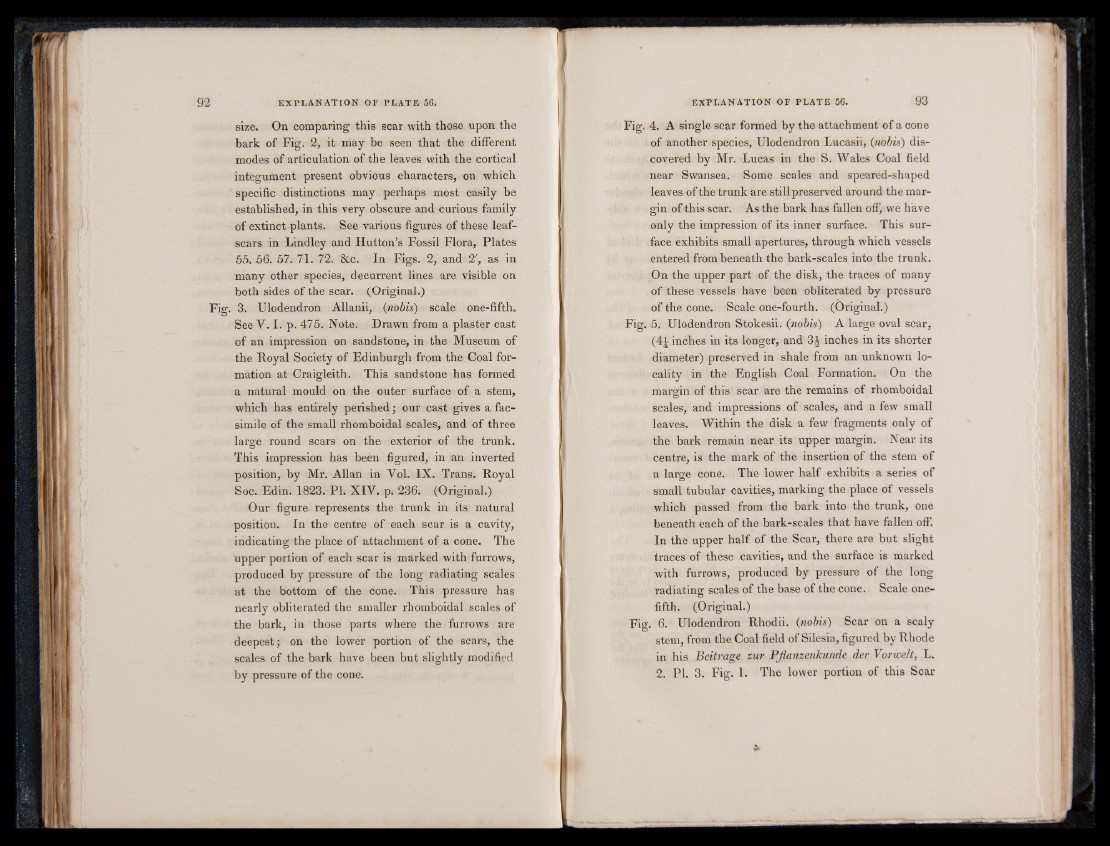
size. On comparing this scar with those upon the
bark of Fig. 2, it may be seen that the different
modes of articulation of the leaves with the cortical
integument present obvious characters, on which
specific distinctions may perhaps most easily be
established, in this very obscure and curious family
of extinct plants. See various figures of these leaf-
scars in Lindley and Hutton’s Fossil Flora, Plates
55. 56. 57. 71. 72. &c. In Figs. 2, and 2', as in
many other species, decurrent lines are visible on
both sides of the scar. (Original.)
Fig. 3. Ulodendron Allanii, (nobis) scale one-fifth.
See V. I. p. 475. Note. Drawn from a plaster cast
of an impression on sandstone, in the Museum of
the Royal Society of Edinburgh from the Coal formation
at Craigleith. This sandstone has formed
a natural mould on the outer surface of a stem,
which has entirely perished; our cast gives a facsimile
of the small rhomboidal scales, and of three
large round scars on the exterior of the trunk.
This impression has been figured, in an inverted
position, by Mr. Allan in Vol. IX. Trans. Royal
Soc. Edin. 1823. PI. XIV. p. 236. (Original.)
Our figure represents the trunk in its natural
position. In the centre of each scar is a cavity,
indicating the place of attachment of a cone. The
upper portion of each scar is marked with furrows,
produced by pressure of the long radiating scales
at the bottom of the cone. This pressure has
nearly obliterated the smaller rhomboidal scales of
the bark, in those parts where the furrows are
deepest; on the lower portion of the scars, the
scales of the bark have been but slightly modified
by pressure of the cone.
Fig. 4. A single scar formed by the attachment of a cone
of another species, Ulodendron Lucasii, (nobis) discovered
by Mr. Lucas in the S. Wales Coal field
near Swansea. Some scales and speared-shaped
leaves of the trunk are still preserved around the margin
of this scar. As the bark has fallen off, we have
only the impression of its inner surface. This surface
exhibits small apertures, through which vessels
entered from beneath the bark-scales into the trunk.
On the upper part of the disk, the traces of many
of these vessels have been obliterated by pressure
of the cone. Scale one-fourth. (Original.)
Fig. 5. Ulodendron Stokesii. (nobis) A large oval scar,
(4j inches in its longer, and 3 | inches in its shorter
diameter) preserved in shale from an unknown locality
in the English Coal Formation. On the
margin of this scar are the remains of rhomboidal
scales, and impressions of scales, and a few small
leaves. Within the disk a few fragments only of
the bark remain near its upper margin. Near its
centre, is the mark of the insertion of the stem of
a large cone. The lower half exhibits a series of
small tubular cavities, marking the place of vessels
which passed from the bark into the trunk, one
beneath each of the bark-scales that have fallen off.
In the upper half of the Scar, there are but slight
traces of these cavities, and the surface is marked
with furrows, produced by pressure of the long
radiating: scales of the base of the cone. Scale one-
fifth. (Original.)
Fig. 6. Ulodendron Rhodii. (nobis) Scar on a scaly
stem, from the Coal field of Silesia, figured by Rhode
in his Beitrage zur PJianzenkunde der Vorwelt, L.
2. PI. 3. Fig. 1. The lower portion of this Scar
&